Hello, Today we'll see how to make a fully responsive modern portfolio using pure HTML, CSS and JS. No other library. You learn to create responsive design, you'll learn about CSS pseudo elements. You'll learn about nodemailer to make a working contact form. And much more.
To see demo or you want coding tutorial with explanation. You can watch the tutorial below.
Video Tutorial
I appreciate if you can support me by subscribing my youtube channel.
So, without wasting more time let's see how to code this.
Code
Before we start writing our code. Let's see its folder structure.
And yes, it is a nodeJS app because we want working mailing system and only servers can send mail not client side browser.
As you can notice, we have project.js file. This files contain our project data. Having a project data make easier for you to add and delete or edit any project you want. Let's see its data structure.
let projects = [
{
name: "project one",
tags: "#javascript, #fullstack, #ui/ux, #backend",
image: "project (1).png",
},
{
name: "project two",
tags: "#javascript, #fullstack",
image: "project (2).png",
},
// +8 more
]
You can see we have project name, its tags, and image path. This way we can easily handle our projects without editing any code.
So let's start by initializing NPM.
NPM init
Inside your root directory outside public folder, open your command prompt or terminal and run npm init cmd. This will initialize NPM to your projects.
Now run this command to install these libraries.
npm i express.js nodemon nodemailer dotenv
express.js - is to create a server
nodemon - is to run server continuously
nodemailer - is to send mails
dotenv - is for making environment variable. We'll use this store our email id and password outside of server.
After done installing libraries. Let's make some changes in package.json. Open it. And change its scripts data.
"scripts": {
"start": "nodemon server.js"
},
Then make server.js file inside your root directory (not in public folder). Open it.
Server.js
Start by importing libraries/packages.
const express = require('express');
const path = require('path');
const nodemailer = require('nodemailer');
const dotenv = require('dotenv');
Setup dotenv so we can access environment variable.
dotenv.config();
Then store your public folder path to a variable and make server.
let initialPath = path.join(__dirname, "public");
let app = express();
Now use app.use method to setup middlewares.
app.use(express.static(initialPath));
app.use(express.json());
They both are important, express.json will enable form data sharing and express.static will set public folder as a static path.
After this make home route. And send index.html file.
app.get('/', (req, res) => {
res.sendFile(path.join(initialPath, "index.html"));
})
And at last, make server listen on 3000 port.
app.listen(3000, () => {
console.log('listening.....');
})
So, our server is done for now. Let's run the server by running npm start cmd on your terminal.
Now let's start working on portfolio.
Portfolio
Open index.html and write basic HTML structure. Then link style.css and app.js to the file. After that make navbar.
<!-- navbar -->
<nav class="navbar">
<h1 class="brand">logo</h1>
<div class="toggle-btn">
<span></span>
<span></span>
</div>
<ul class="links-container">
<li class="links-item"><a href="#" class="link active">home</a></li>
<li class="links-item"><a href="#project-section" class="link">project</a></li>
<li class="links-item"><a href="#about-section" class="link">about</a></li>
<li class="links-item"><a href="#contact-section" class="link">contact</a></li>
</ul>
</nav>
And give it some styles.
*{
margin: 0;
padding: 0;
box-sizing: border-box;
}
html{
scroll-behavior: smooth;
}
body{
width: 100%;
position: relative;
background: #1d1d1d;
color: #fff;
font-family: 'roboto', sans-serif;
}
/* navbar */
.navbar{
position: fixed;
top: 0;
left: 0;
width: 100%;
height: 60px;
background: #1d1d1d;
padding: 0 10vw;
display: flex;
justify-content: space-between;
align-items: center;
z-index: 9;
}
.brand{
text-transform: capitalize;
font-weight: 500;
}
.links-container{
display: flex;
list-style: none;
}
.link{
text-transform: capitalize;
color: #fff;
text-decoration: none;
margin: 0 10px;
padding: 10px;
position: relative;
}
.link:hover:not(.active){
opacity: 0.7;
}
.link.active::before,
.seperator::before{
content: '';
position: absolute;
bottom: 0;
left: 50%;
transform: translateX(-50%);
width: 5px;
height: 5px;
border-radius: 50%;
background: #fff;
}
.link.active::after,
.seperator::after{
content: '';
position: absolute;
bottom: 2px;
left: 0;
width: 100%;
height: 1px;
background: #fff;
}
Note
- You can see
scroll-behaviorgiven tohtml. If you don't give this you'll not be able to get smooth scrolling effect. - you can also see
seperatorelement in the styles but don't worry we'll create this later.
Output
Now create header section
<!-- home section -->
<section class="home">
<div class="hero-content">
<h1 class="hero-heading"><span class="highlight">hi, </span>i am john</h1>
<p class="profession">web developer</p>
<p class="info">Lorem ipsum dolor sit amet consectetur adipisicing elit. Consequatur odit in laudantium suscipit blanditiis asperiores.</p>
<a href="#contact-section" class="btn">contact</a>
</div>
<img src="img/img1.png" class="image" alt="">
</section>
/* home section */
.home{
width: 100%;
min-height: calc(100vh - 60px);
height: auto;
margin-top: 60px;
padding: 0 10vw;
display: flex;
align-items: center;
justify-content: space-between;
position: relative;
}
.hero-content{
width: 50%;
}
.hero-heading{
font-size: 5rem;
text-transform: capitalize;
font-weight: 500;
}
.highlight{
color: #ff3559;
}
.profession{
width: fit-content;
display: block;
margin: 10px 0 20px;
margin-left: auto;
text-transform: capitalize;
position: relative;
padding: 10px 20px;
color: #1d1d1d;
z-index: 2;
}
.profession::before{
content: '';
position: absolute;
top: 0;
left: 0;
width: 100%;
height: 100%;
background: #e3e3e3;
z-index: -1;
transform: skewX(10deg);
}
.profession::after{
content: '';
position: absolute;
top: 0;
left: -100px;
width: 100px;
height: 2px;
background: #e3e3e3;
}
.info{
line-height: 30px;
margin-bottom: 50px;
}
.btn{
padding: 10px 20px;
text-decoration: none;
border-radius: 50px;
background: #ff3559;
color: #fff;
text-transform: capitalize;
border: none;
}
Output
Great! now make about section.
<!-- about section -->
<section class="about" id="about-section">
<h2 class="heading">about <span class="highlight">me</span></h2>
<p class="sub-heading">Lorem ipsum dolor sit amet consectetur. </p>
<div class="seperator"></div>
<div class="about-me-container">
<div class="left-col">
<img src="img/img2.png" class="about-image" alt="">
</div>
<div class="right-col">
<p class="about-para">Lorem ipsum dolor sit amet, consectetur adipisicing elit. Accusamus totam quia numquam tempora nostrum earum similique enim laudantium iusto. Quaerat illo numquam minus pariatur, cum qui ipsum sapiente, atque optio voluptatibus necessitatibus, quis dolores veniam delectus inventore beatae? Accusamus, illum! Non nam dolores assumenda quibusdam repellat beatae quae eum atque sed, velit culpa, at animi cumque suscipit. Ratione delectus dolores odit dicta ipsum libero molestiae et reprehenderit sapiente earum. Alias aut architecto quis, earum iusto beatae quibusdam maiores, rerum, consequatur aliquid doloribus? Quas accusantium quidem eos ex, aperiam recusandae. Veritatis?</p>
<a href="#" class="btn">download cv</a>
</div>
</div>
</section>
/* about section */
.about{
width: 100%;
height: auto;
padding: 50px 10vw;
}
.heading{
text-align: center;
font-weight: 500;
font-size: 3.5rem;
text-transform: capitalize;
}
.sub-heading{
text-align: center;
font-size: 1rem;
margin: 10px;
opacity: 0.7;
}
.seperator{
width: 25%;
margin: 20px auto;
position: relative;
}
.about-me-container{
margin: 150px 0 100px;
width: 100%;
display: grid;
grid-template-columns: 40% 60%;
grid-gap: 50px;
}
.left-col, .right-col{
position: relative;
}
.left-col::before{
content: 'yes, its me';
text-transform: capitalize;
position: absolute;
right: 0;
top: -20px;
}
.left-col::after{
content: '';
position: absolute;
top: -10px;
right: 80px;
width: 50px;
height: 2px;
background: #fff;
transform-origin: right;
transform: rotate(-30deg);
}
.about-image{
border-radius: 10px;
box-shadow: 0 10px 10px rgba(0, 0, 0, 0.25);
}
.about-para{
font-size: 1.2rem;
font-weight: 300;
line-height: 35px;
margin-bottom: 40px;
}
Output
And now create skills section. Add this structure inside about section.
<section class="about" id="about-section">
//previous elements
<h2 class="heading">languages and framework i know</h2>
<div class="seperator"></div>
<div class="skill-container">
<div class="skill-card" style="--bg: #f06529">
<p class="skill">HTML</p>
</div>
<div class="skill-card" style="--bg: #379ad6">
<p class="skill">CSS</p>
</div>
<div class="skill-card" style="--bg: #cc6699">
<p class="skill">SCSS</p>
</div>
<div class="skill-card" style="--bg: #f7df1e">
<p class="skill">JavaScript</p>
</div>
<div class="skill-card large" style="--bg: #5ed9fb">
<p class="skill">ReactJS</p>
</div>
<div class="skill-card large" style="--bg: #83cd29">
<p class="skill">NodeJS</p>
</div>
<div class="skill-card" style="--bg: #326690">
<p class="skill">Postgres SQL</p>
</div>
<div class="skill-card" style="--bg: #ffa000">
<p class="skill">Firebase</p>
</div>
<div class="skill-card large" style="--bg: #5ed9fb">
<p class="skill">Much More</p>
</div>
</div>
</section>
You can notice we have style="--bg: value" to skill-card element. What this is doing is, it is setting up different --bg CSS variable for different elements. So this way we can add same effect with different colors.
.skill-container{
position: relative;
margin-top: 100px;
display: grid;
grid-template-columns: repeat(4, 1fr);
grid-gap: 20px;
}
.skill-card{
height: 200px;
border-radius: 10px;
border: 1px solid #464646;
text-align: center;
position: relative;
cursor: pointer;
transition: .5s;
}
.skill{
font-size: 2rem;
color: #464646;
line-height: 200px;
}
.skill-card:hover{
background: var(--bg);
}
.skill-card:hover .skill{
color: #fff;
}
.skill-card.large{
grid-column: 2 span;
}
Output
background color is showing on hover
Now, let's create project section. In project section first make filter buttons.
<!-- project section -->
<section class="project" id="project-section">
<h2 class="heading">Project<span class="highlight">s</span></h2>
<p class="sub-heading">Lorem ipsum dolor sit amet consectetur. </p>
<div class="seperator"></div>
<div class="filters">
<button class="filter-btn active" id="all">all</button>
<button class="filter-btn" id="javascript">javaScript</button>
<button class="filter-btn" id="ui">ui/ux</button>
<button class="filter-btn" id="backend">backend</button>
<button class="filter-btn" id="fullstack">fullStack</button>
</div>
</section>
The id attribute in filters will help us in filtering the projects.
/* project section */
.project, .contact{
position: relative;
padding: 50px 10vw;
}
.filters{
width: fit-content;
display: block;
margin: 100px auto;
}
.filter-btn{
padding: 10px 20px;
border-radius: 5px;
border: none;
text-transform: capitalize;
margin: 0 5px 10px;
cursor: pointer;
}
.filter-btn.active{
background: #ff3559;
color: #fff;
}
Output
And now just for styling purpose make single project card.
<div class="project-container">
<div class="project-card">
<img src="img/project (1).png" alt="">
<div class="content">
<h1 class="project-name">project one</h1>
<span class="tags">#javascript</span>
</div>
</div>
</div>
.project-container{
width: 100%;
display: grid;
grid-template-columns: repeat(4, 1fr);
grid-gap: 20px;
}
.project-card{
position: relative;
cursor: pointer;
display: block;
}
.project-card img{
width: 100%;
height: 100%;
object-fit: cover;
}
.project-card .content{
position: absolute;
top: 0;
left: 0;
width: 100%;
height: 100%;
background: rgba(0, 0, 0, 0.7);
display: flex;
justify-content: center;
align-items: center;
transition: .5s;
text-transform: capitalize;
opacity: 0;
}
.project-name{
font-weight: 300;
font-size: 2.5rem;
text-align: center;
}
.tags{
position: absolute;
bottom: 20px;
opacity: 0.6;
width: 90%;
}
.project-card:hover .content{
opacity: 1;
}
.project-card.hide{
display: none;
}
Output
Content is showing on hover
Now you can comment the project card.
<div class="project-container">
<!-- <div class="project-card">
<img src="img/project (1).png" alt="">
<div class="content">
<h1 class="project-name">project one</h1>
<span class="tags">#javascript</span>
</div>
</div> -->
</div>
And let's make project card dynamically. But before doing that. Add you project.js file before app.js file. Otherwise you'll not be able to access project data.
<script src="project.js"></script>
<script src="app.js"></script>
Now open app.js. And before making project card. Let make the links toggle active class. For that code this.
// links
const links = document.querySelectorAll('.link');
links.forEach(link => {
link.addEventListener('click', () => {
links.forEach(ele => ele.classList.remove('active'));
link.classList.add('active');
})
})
And after doing that we are good to go on project cards. So code this.
// creating dynamic project card
const projectContainer = document.querySelector('.project-container');
projects.forEach(project => {
projectContainer.innerHTML += `
<div class="project-card" data-tags="#all, ${project.tags}">
<img src="img/${project.image}" alt="">
<div class="content">
<h1 class="project-name">${project.name}</h1>
<span class="tags">${project.tags}</span>
</div>
</div>
`;
})
You can see we are just selecting the project container and then looping through the data to make cards.
Output
Great! now make filter button functional.
// filters
const filters = document.querySelectorAll('.filter-btn');
filters.forEach(filterBtn => {
filterBtn.addEventListener('click', () => {
let id = filterBtn.getAttribute('id');
let projectCards = document.querySelectorAll('.project-card');
projectCards.forEach(card => {
if(card.getAttribute('data-tags').includes(id)){
card.classList.remove('hide');
} else{
card.classList.add('hide');
}
})
filters.forEach(btn => btn.classList.remove('active'));
filterBtn.classList.add('active');
})
})
In above code, we are just adding click event to filter button and toggling some elements class.
So out project section is fully done. Now, make contact form.
<!-- contact form -->
<section class="contact" id="contact-section">
<h2 class="heading">Contact<span class="highlight"> me</span></h2>
<p class="sub-heading">Lorem ipsum dolor sit amet consectetur. </p>
<div class="seperator"></div>
<div class="contact-form">
<div class="name">
<input type="text" class="first-name" required placeholder="first name">
<input type="text" class="last-name" required placeholder="last name">
</div>
<input type="email" required class="email" placeholder="email">
<textarea class="message" placeholder="message" required></textarea>
<button class="btn contact-btn">contact</button>
</div>
</section>
<footer class="footer">made with love by modern web</footer>
/* contact form */
.contact-form{
width: 100%;
margin-top: 100px;
position: relative;
}
.contact-form input, .message{
width: 100%;
display: block;
height: 50px;
padding: 20px;
border-radius: 5px;
background: #000;
color: #fff;
border: none;
outline: none;
margin: 30px 0;
text-transform: capitalize;
resize: none;
}
.message{
height: 200px;
}
.contact-form .name{
display: flex;
justify-content: space-between;
}
.name input{
width: 49%;
margin: 0;
}
.contact-form .btn{
display: block;
margin: auto;
cursor: pointer;
}
/* footer */
.footer{
width: 100%;
height: 30px;
text-align: center;
background-color: #ff3559;
text-transform: capitalize;
line-height: 30px;
}
Output
Now, let's make mail route inside server.js
app.post('/mail', (req, res) => {
const { firstname, lastname, email, msg } = req.body;
const transporter = nodemailer.createTransport({
service: 'gmail',
auth: {
user: process.env.EMAIL,
pass: process.env.PASSWORD
}
})
const mailOptions = {
from: 'sender email',
to: 'receiver email',
subject: 'Postfolio',
text: `First name: ${firstname}, \nLast name: ${lastname}, \nEmail: ${email}, \nMessage: ${msg}`
}
transporter.sendMail(mailOptions, (err, result) => {
if (err){
console.log(err);
res.json('opps! it seems like some error occured plz. try again.')
} else{
res.json('thanks for e-mailing me. I will reply to you within 2 working days');
}
})
})
This is a way to send mail with nodemailer. There are some thing you have to notice.
-
process.env.EMAIL&process.env.PASSWORDthis keyword give you access to environment variable but we haven't made any variable, for that. Create a file in your root directory.env. Name should be the same. Open it and type this.
EMAIL=your email
PASSWORD=your email's password
So now if you understand, process.env will access these variables.
-
from&toparameters. In the code above I have not entered my email's but in order to make mail work you have to give email id as their params. You can give same email id to both.
So out server is fully done. Now, make contact form working.
//contact form
const contactBtn = document.querySelector('.contact-btn');
const firstName = document.querySelector('.first-name');
const lastName = document.querySelector('.last-name');
const email = document.querySelector('.email');
const msg = document.querySelector('.message');
contactBtn.addEventListener('click', () => {
if(firstName.value.length && lastName.value.length && email.value.length && msg.value.length){
fetch('/mail', {
method: 'post',
headers: new Headers({'Content-Type': 'application/json'}),
body: JSON.stringify({
firstname: firstName.value,
lastname: lastName.value,
email: email.value,
msg: msg.value,
})
})
.then(res => res.json())
.then(data => {
alert(data);
})
}
})
In above code, I am just selecting all forms input and making POST request to /mail route.
Our contact form is also. Done.
Now make this website responsive.
Responsive - Tablet
/* tablet view */
@media (max-width: 996px){
html{
font-size: 14px;
}
/* toggle btn */
.toggle-btn{
position: absolute;
width: 40px;
height: 40px;
right: 10vw;
cursor: pointer;
}
.toggle-btn span{
position: absolute;
width: 100%;
height: 2px;
background: #fff;
top: 30%;
transition: .5s;
}
.toggle-btn span:nth-child(2){
top: 70%;
}
.toggle-btn.active span:nth-child(1){
top: 50%;
transform: rotate(45deg);
}
.toggle-btn.active span:nth-child(2){
top: 50%;
transform: rotate(-45deg);
}
/* links */
.links-container{
position: absolute;
top: 60px;
background: #1d1d1d;
width: 100%;
left: 0;
padding: 0 10vw;
flex-direction: column;
transition: .5s;
opacity: 0;
pointer-events: none;
}
.links-container.show{
opacity: 1;
pointer-events: all;
}
.link{
margin-left: auto;
text-align: center;
display: block;
height: 50px;
}
/* home section */
.home{
flex-direction: column-reverse;
height: fit-content;
padding-bottom: 50px;
}
.home .image{
width: 250px;
margin: 40px;
}
.hero-content{
width: 70%;
min-width: 350px;
text-align: center;
}
.hero-heading{
font-size: 4.5rem;
}
/* about-section */
.about-me-container{
grid-template-columns: 1fr;
}
.left-col{
margin: auto;
width: 50%;
min-width: 320px;
}
.skill-container, .project-container{
grid-template-columns: repeat(2, 1fr);
}
.skill-card{
grid-column: 1 span !important;
}
}
You can see we are styling toggle-btn here. But to make it function you need to code this inside app.js.
//toggle button
const toggleBtn = document.querySelector('.toggle-btn');
const linkContainer = document.querySelector('.links-container');
toggleBtn.addEventListener('click', () => {
toggleBtn.classList.toggle('active');
linkContainer.classList.toggle('show');
})
Responsive - Mobile
/* mobile view */
@media (max-width: 500px){
html{
font-size: 12px;
}
p, .sub-heading, .about-para, .left-col::before, .tags{
font-size: 1.4rem;
}
.about-image{
width: 90%;
margin: auto;
display: block;
}
.skill-container, .project-container{
grid-template-columns: 1fr;
}
.skill{
font-size: 2.5rem;
}
.project-name{
font-size: 3rem;
}
.name{
flex-direction: column;
}
.name input{
width: 100%;
}
.first-name{
margin-bottom: 20px !important;
}
}
You can watch responsive part on video tutorial for output
So that's it. I hope you understood each and everything. If you have doubt or I missed something let me know in the comments.
Articles you may find Useful
I really appreciate if you can subscribe my youtube channel. I create awesome web contents.
Thanks For reading.

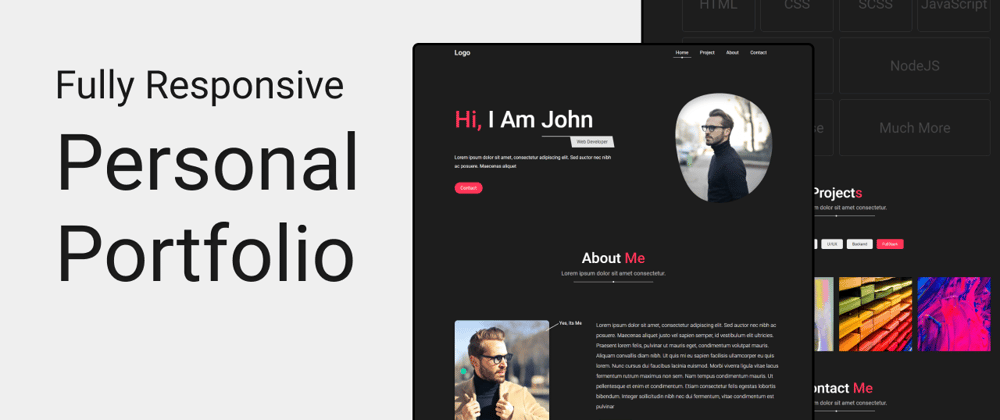


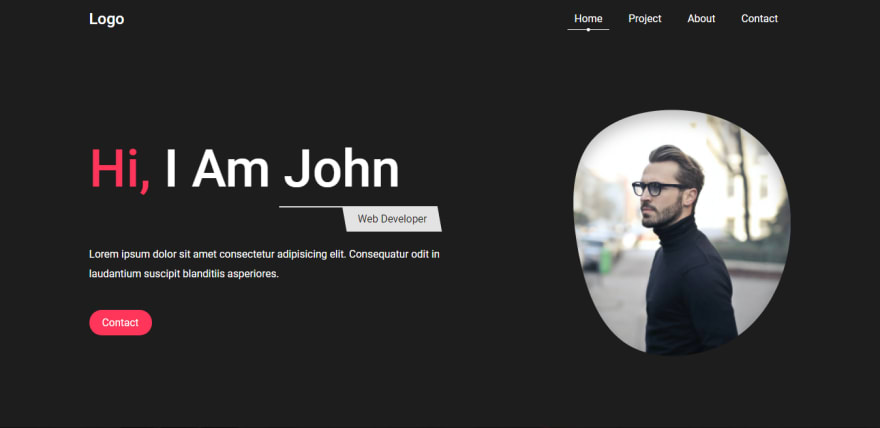
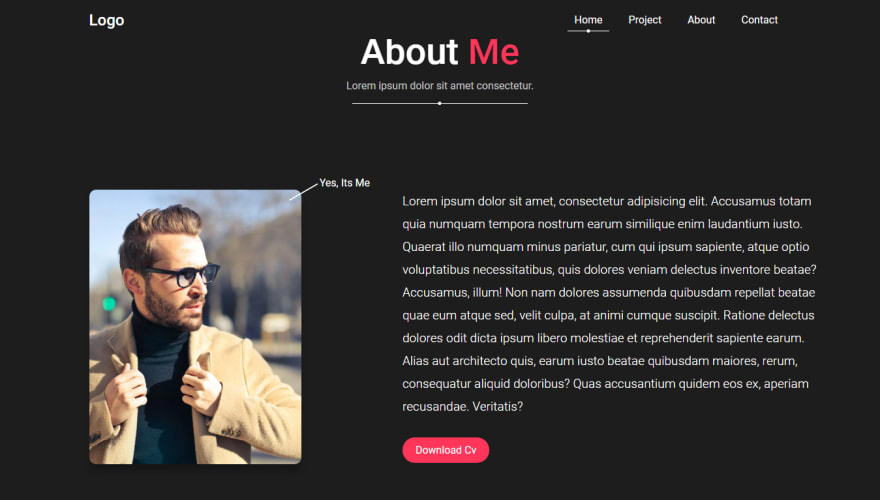


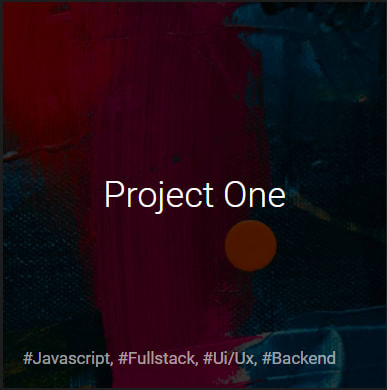
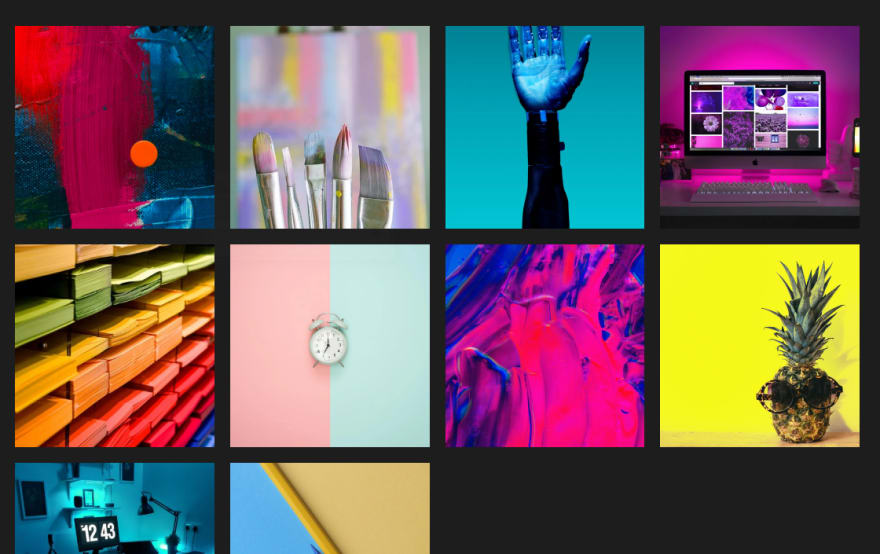
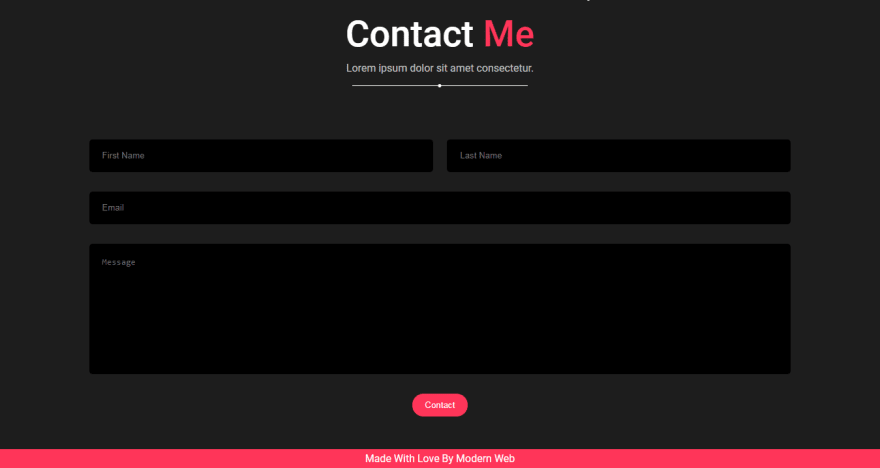






Top comments (21)
Thank you for this article. When I hire a programmer , I'm hiring a programmer. I don't hire I don't hire someone that knows just a framework. To me that's worthless unless you are very strong at the underlying technologies. all too often New people go for the instant gratification of a framework and fail to understand the theoretical and technical underpinnings
as a young programmer, I would really love if you could please explain what do you exactly mean and expect from an employee by theoretical and technical underpinning 😊
Like, understand under the hood of programming before going to frameworks.
As an example. If you were applying for a frontend web developer position, I would expect you to know how browsers populate the page. developer.mozilla.org/en-US/docs/W...
I would also expect that you were well versed in vanilla ES6+, Vanilla CSS and HTML and solid technical writing skills. I would expect that you understood algorithm design, complexity, version contol and Linux. This is for a junior position. I would also expect you to have an Bachelors of Science degree. This would indicate to me that you have a mathematical background up to at least "diff eq", and an understanding of root cause analysis. No BS degree = no interview. That's not to say that everyone with a BS is qualified only to say that if you don't have one, you are disqualified. You wouldn't trust a doctor, dentist or attorney that didn't have a degree and there is no reason programming positions should be any different.
Well what you say after seeing my work. Am i qualified caz' I don't have any degree 😂😂
It's not a laughing matter, nor is it me questioning your worth as a human being. My answer to your question though is a resounding no. Imagine if you went to a law firm and applied to be a lawyer there. Would you have a chance? Certainly not. This is no different. I'm sure many people can give anecdotal reasons why someone might not need a degree, but they are talking about extreme outliers and certainly not the general norm. Again come up just because you have a degree doesn't mean you'll be good at the career, but not having a degree does preclude you from it.
Good post. Nice explanation of core fundamentals. You can reduce your code a little if you write styles on html tags directly where possible. Like on
<footer class="footer">you can write styles directly on footer tag instead of giving it a class. But its a personal choice. I appreciate your post for focusing on proper basic concepts instead of some half baked tutorial on framework.Yep, I def like having the frame of my layout created with all semantic tags and targeting then with css without using classes but tag name, footer, nav, header, aside, etc..
Hello Bhai, It's OSM👍💗
❤️
Awesome!
Nice work, well done👍
Thanks
Amazing... ❤
I really love your design.
Thanks ☺️
Very good post
Thanks☺️
👍Good job!
Thanks☺️😄
send me any resource related to web content
email: josephnadi4@gmail.com
Some comments may only be visible to logged-in visitors. Sign in to view all comments.